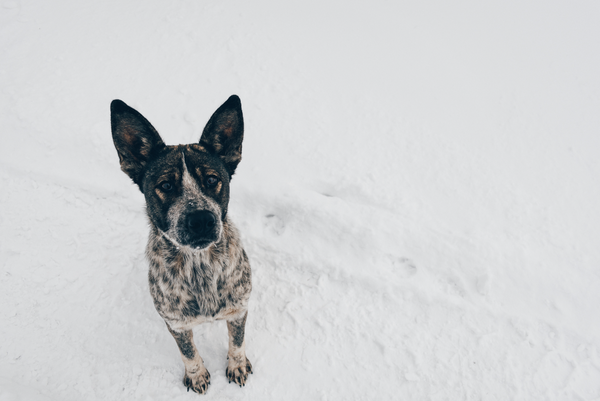Account

Winter dog walking safety tips

Dogs will always demand a walk, even in the most extreme of conditions. There could quite literally be glaciers forming down the road and merciless ice daggers falling from the sky, but they’d still be angling to get out there.
With all that in mind, below are some useful tips for walks in wintry conditions.
PUT THEIR PAWS FIRST
Snow, grit (rock salt) and frozen pavements can all be problematic for paw health.
Let’s start with grit...
It’s undoubtably useful for melting snow and ice and giving us a little bit more grip and reassurance than we might otherwise have had, but it’s actually toxic to both dogs and cats, causing painful burns to the skin on their paws.
There’s also the risk that they might lick any remaining salt caught in their fur, which would result in a higher sodium level and potential vomiting, exhaustion, thirst or kidney damage.
Our tips:
- Simply avoid walking in areas where grit might have been put down (i.e. roads and pavements). Drive to a local park or woodland instead.
- Wipe and brush their feet, fur and bellies immediately after being outside.
- Contact a vet if you’re worried that your dog might have ingested any rock salt.
- Look out for the pet-friendly and non-toxic alternatives to grit and other ice-melts—they’re out there!
Now we can look at snow and ice...
A dog’s toes spread wider when their nails are long, which means that they’re more prone to getting a build-up of snow and ice between their toes. Think of this as being like walking with multiple pebbles in your shoe for a long period of time—it sounds painful, right?
Walks in these conditions can also lead to cracks and peeling paw pads, which are obviously painful.
Our tips:
- Keep nails short and also trim the fur between their toe pads.
- Some dogs can’t handle the cold like others might, so consider some winter dog boots to give them some extra protection.
- Consider using some protective paw wax before heading out and another to moisturise upon returning.

PROTECT FROM BELOW
Due to the lack of fur, your dog’s belly is less protected and will allow the cold in much faster than other parts of their body. Most of the time this shouldn’t be a big problem, but will be if the snow’s deep enough.
Our tips:
- Avoid deep snow…sticking to grit-free paths and pavements instead.
- Go out for shorter walks (read more on this further down).
- Consider styling your pup out with the latest jumper or jacket, for that little bit of extra warmth and protection.
PROTECT FROM ABOVE
Winter (especially here in the UK) can throw almost every type of weather condition your way within the space of a couple of hours. Try to keep your dog's coat as dry as possible at all times, especially when temperatures are below freezing.
Our tips:
- PLAN AHEAD! Check the weather forecast and find a slot where you won’t be caught in a blizzard.
- Always take a spare jacket or jumper with you. Yes…for the dog…not for you. But take another for yourself if likely to be joining your pup in puddles too.

SHORTEN THE DISTANCE
Short and sweet walks mean less risk of dogs suffering from the cold as a result of being out for a prolonged period of time. It also means less chance of experiencing every type of weather.
Keep an eye on your dog. If they’re showing any signs of discomfort (licking paws, whining, shivering or picking up their paws) then get them home or to the car as soon as possible.
BE SEEN
Many of us only have the option of walking our dogs either early in the morning or in the evening. And as the days are shorter, you’ll be going out in the dark. This makes being seen all the more important.
First of all, you don’t want to lose your four-legged friend if you let them off the lead. Secondly, you will want cars, bikes, cyclists and other people spotting them from a distance too.
Our tips:
- A reflective coat at the very least. Full marks for anyone who has a coat or jumper with lights on too.
- Bonus points for collars with lights.
FEED THEM PROPERLY
If your dog tends to get the same amount of exercise year-round, then consider giving them a little extra food in winter.
Why, you ask? Because it takes more energy to exercise in the winter as it does at other times of year.
We have more than a few healthy fish-based dog treats for you to choose from…in case you didn’t already know.

PREVENT SNOW INTAKE
A little is fine, but there are many risks associated with excessive snow intake for dogs.
For one, you can often find anti-freeze, grit and other contaminants mixed in with snow. Another is that it can upset their intestines and cause diarrhoea and vomiting, if an excessive amount is eaten.
Our tips:
- Keep your dog well-hydrated at home and while on walks, to lessen the chance of them wanting to eat snow.
- A short lead will allow you to have a better control of your dog and what they’re licking or eating. This will also help with preventing them going onto any potentially icy rivers or lakes, which are an added danger.
NOW YOU'RE READY FOR ANY ADVENTURE!





